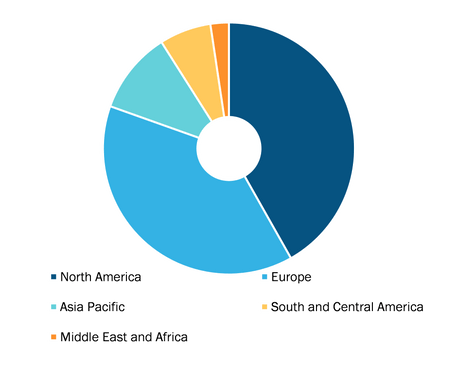North America region to Hold Largest Share in Blood Irradiation Market During 2022–2028
According to our latest study on “Blood Irradiation Market Forecast to 2028 – COVID-19 Impact and Global Analysis – by Type, Indication, and End User,” the market is expected to grow from US$ 65.15 million in 2021 to US$ 104.37 million by 2028; it is estimated to grow at a CAGR of 7.0% from 2022 to 2028. The report highlights the key factors driving the market and prominent players with their developments in the market.
North America held a significant share in the blood irradiation market owing to a constant increase in communicable and noncommunicable diseases, including cancer, cardiovascular disorders, chronic renal disease, and stroke, as a large population is susceptible to such conditions.
Increasing Prevalence of Communicable and Noncommunicable Diseases
There is an increase in the number of incidence of communicable and noncommunicable diseases, including cancer, cardiovascular disorders, chronic renal disease, and stroke, owing to a large population across the world susceptible to such conditions. According to World Health Organization (WHO), cardiovascular disorders are the leading cause of death globally, and ~17.9 million deaths are reported yearly. Additionally, the rising prevalence of communicable diseases, such as Hepatitis, influenza, Human Immunodeficiency Virus (HIV), and acquired immunodeficiency syndrome (AIDS), are driving the growth of the blood irradiation market. According to WHO, 325 million people were infected with the hepatitis B virus in 2020, and 900,000 people die from hepatitis B virus infection every year. Moreover, a large geriatric population across the world is contributing to the prevalence of noncommunicable diseases, such as cardiovascular disorders, renal disorders, and strokes. According to WHO, the population of people aged 60 years and above was 1 billion in 2019 and is expected to increase to 1.4 billion by 2030 and 2.1 billion by 2050. The elderly population is susceptible to noncommunicable disease conditions owing to various factors such as poor nutrition, lack of physical activity, excessive use of tobacco, and consumption of alcohol.
Additionally, surging blood transfusion owing to an increase in surgical procedures, accidents, trauma cases, and disorders, along with the rising prevalence of bloodstream infections, supports the market growth. Bloodstream infections, underlying conditions, and invasive procedures are common among the geriatric population. Bloodstream infections are the major cause of illness and death among large populations. According to the National Library of Medicine, ~28,000 bloodstream infections occur across the world annually. Moreover, rising awareness about bloodstream infections and increasing immune responses to transfused blood can cause complications as increasing use of irradiated blood in cancer treatment strengthens the immune system and improves overall health of patients, which is driving the growth of the blood irradiation market.
Impact of COVID-19 Pandemic on Blood Irradiation Market:
The COVID-19 outbreak has resulted in dramatic reductions in nonurgent medical services. From 2020 to mid-2021, countries around the world have imposed lockdowns. The lockdowns delayed hospital visits, which showed a critical impact on health and delayed the diagnosis of various critical conditions, such as a tumor, cardiovascular diseases, solid tumors, and other abnormalities. Hospitals experienced drastic reductions in procedures carried out for both communicable and noncommunicable diseases. However, delayed therapy is often not feasible for patients requiring treatment for acute leukemia or stem cell transplantation. COVID-19 crisis held significant challenges to transfusion services, leading to a shortage of blood component and the potential risk for patients to get infected from donor or staff. The COVID-19 pandemic is an unprecedented event and had adversely affected health care services globally. Management of high-risk cancers and stem cell transplants must continue as before while mitigating the risk of acquiring infection. Several amendments to the routine management approach to acute leukemia are recommended by experts. These changes, along with basic measures including hand hygiene, surface cleaning, mandatory mask use, social distancing, and reducing hospital stays, are effective steps that can permit the continuation of treatment while minimizing the risk of COVID-19.
The lockdown allowed only emergency procedures with stringent preventive measures to avoid the spread of the virus. It has also led to the closure of product units, sales, supply chain, and R&D activities for blood irradiation. Governments relaxed the restrictions on various services, which has created opportunities for the growth of the blood irradiation market. Thus, the COVID-19 pandemic has shown a moderate impact on the blood irradiation market.
Typenex Medical, LLC; Hitachi Medical Systems; Rad Source Technologies; Gilardoni S.p.A.; Gamma-Service Medical GmbH; Actemium; and Best Theratronics Ltd. are among the leading companies operating in the blood irradiation market.
Blood Irradiation Market, by Region, 2021 (%)
Blood Irradiation Market Forecast to 2028 - COVID-19 Impact and Global Analysis By Type (Intravenous Laser Blood Irradiation, Transcutaneous Laser Blood Irradiation, and Extracorporeal Blood Irradiation), Indication (Acute Leukemia, Lymphoma, Solid Tumors, Pelvic Tumors, and Others), and End User (Hospitals, Blood Banks, Diagnostics Clinics, and Research Institutes)
Blood Irradiation Market Share and Growth by 2028
Download Free Sample
Based on type, the blood irradiation market is segmented into intravenous laser blood radiation, transcutaneous laser blood radiation, and extracorporeal blood radiation. Based on indication, the market is segmented into acute leukemia, solid tumors, pelvic tumors, lymphoma, and others. By end user, the blood irradiation market is segmented into hospitals, blood banks, diagnostics clinics, and research institutes. Based on geography, the market is segmented into North America (the US, Canada, and Mexico), Europe (France, Germany, the UK, Spain, Italy, and the Rest of Europe), Asia Pacific (China, India, Japan, Australia, South Korea, and the Rest of Asia Pacific), the Middle East & Africa (Saudi Arabia, the UAE, South Africa, and the Rest of Middle East & Africa), and South & Central America (Brazil, Argentina, and the Rest of South & Central America).\